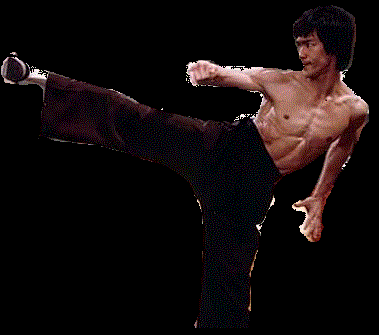A shuriken (Japanese 手裏剣; literally: "sword hidden in the hand") is a traditional Japanese concealed weapon that was generally used for throwing, and sometimes stabbing or slashing. They are sharpened hand-held blades made from a variety of everyday items, such as needles, nails, and knives, as well as coins, washers, and other flat plates of metal. Shuriken is the name given to any small-bladed object, while shakenis traditionally used to indicate the well-known "throwing star".
Shuriken are commonly known in the West as throwing stars or ninja stars though they took many different shapes and designs during the time they were used. The major varieties of shuriken are the bō shuriken (棒手裏剣, stick shuriken) and the hira shuriken (平手裏剣, flat shuriken) orshaken (車剣, also read as kurumaken, wheel shuriken).
Shuriken were mainly a supplemental weapon to the more-commonly-used sword or other various weapons in a samurai warrior's arsenal, though they often played a pivotal tactical role in battle. The art of wielding the shuriken is known as shurikenjutsu and was mainly taught as a minor part of the martial arts curriculum of many famous schools, such as Yagyū Shinkage-ryū, Tenshin Shōden Katori Shintō-ryū, Ittō-ryū, Kukishin-ryū, and Togakure-ryū.
Shuriken



Bo shuriken:
Bo-shuriken are throwing weapons consisting of a straight iron or steel spike, usually four-sided but sometimes round or octagonal in shape. They are usually single-pointed, but some have points on both sides. The length of bo-shuriken ranges from 12 to 21 cm (5–81⁄2 in) and the average weight was from 35 to 150 grams (1.2–5.4 ounces).
The bo-shuriken is thrown in a number of ways, such as overhead, underarm, sideways and rearwards, but in each case, the throw involved the blade sliding out of the hand through the fingers in a smooth, controlled flight. This is not to be confused with the kunai, which is a thrusting and stabbing implement that is sometimes thrown.
The major forms of throw are the jiki da-ho (direct hit method), and the han-ten da-ho (turning hit method). These two forms are technically different, in that the former does not allow the blade to spin before it hits the target, while the latter requires that the blade spin before it hits the target.
Bo-shuriken were constructed from a wide variety of everyday items, and thus there are many shapes and sizes. Some derive their name from the materials they were fashioned from, such as kugi-gata (nail form), hari-gata (needle form) and tantō-gata (knife form); others are named after the object to which they appear similar, such as hoko-gata (spear form), matsuba-gata (pine-needle form) while others were simply named after the object that was thrown, such askankyuto (piercing tool form), kunai-gata (utility tool form), or teppan (plate metal) and biao (pin).
Other items were also thrown as in the fashion of bo-shuriken, such as kogai (ornamental hairpin), kogata (utility knife) and hashi (chopsticks), although these items were not associated with any particular school of shurikenjutsu, rather they were more likely just thrown at opportune moments by a skilled practitioner who was skilled in a particular method or school.
The origins of the bo-shuriken in Japan are still unclear despite continuing research in this area. This is partly because shurikenjutsu is a secretive art, and also to the fact that throughout early Japanese history there were actually many independent innovators of the skill of throwing long, thin objects. The earliest known mention of a school teaching shurikenjutsu is Ganritsu Ryu, prevalent during the 17th century. This school utilized a long, thin implement with a bulbous head, thought to be derived from the arrow. Existing examples of blades used by this school appear to exhibit a mixture of an arrow's shape with that of a needle traditionally used in Japanese leatherwork and armor manufacture.
There are also earlier mentions in written records, such as the Osaka Gunki (大阪軍記, the military records of Osaka), of the standard knife and short sword being thrown in battle, and Miyamoto Musashi is said to have won a duel by throwing his short sword at his opponent, killing him.



